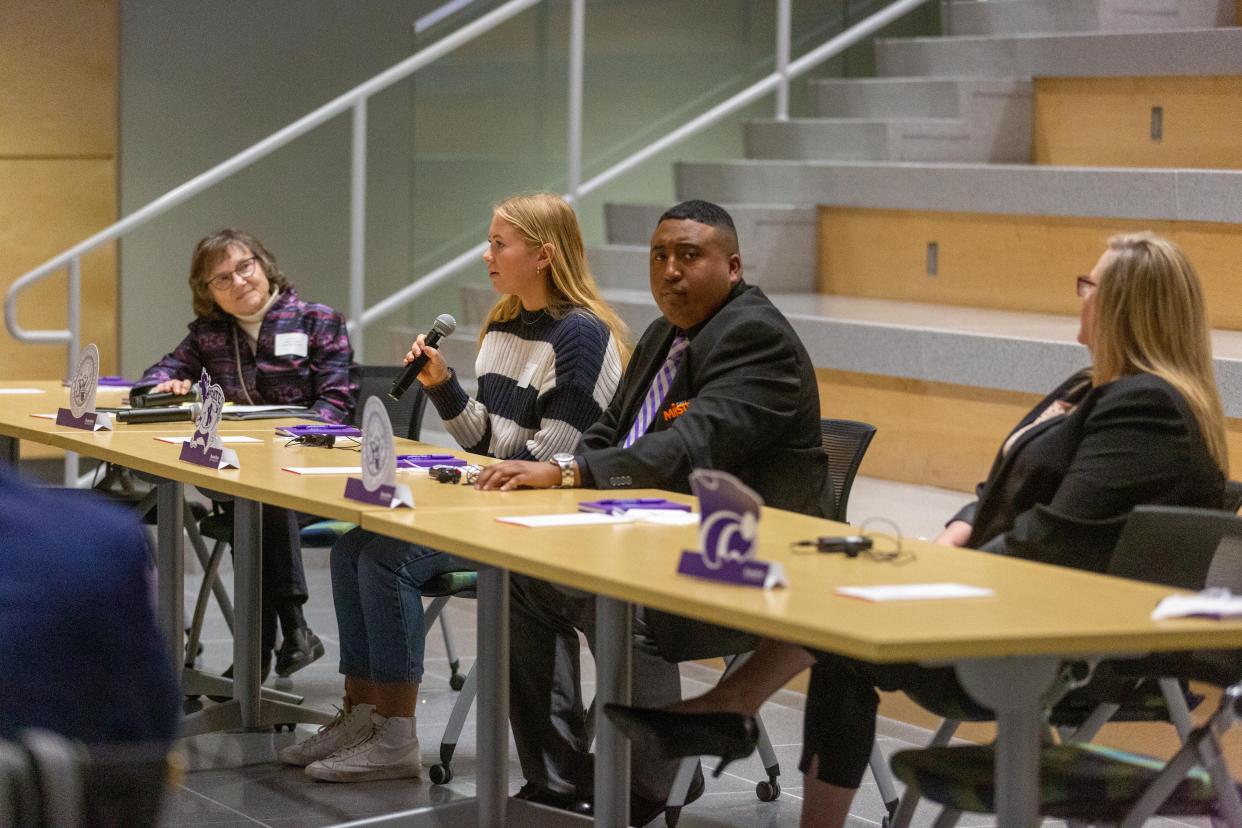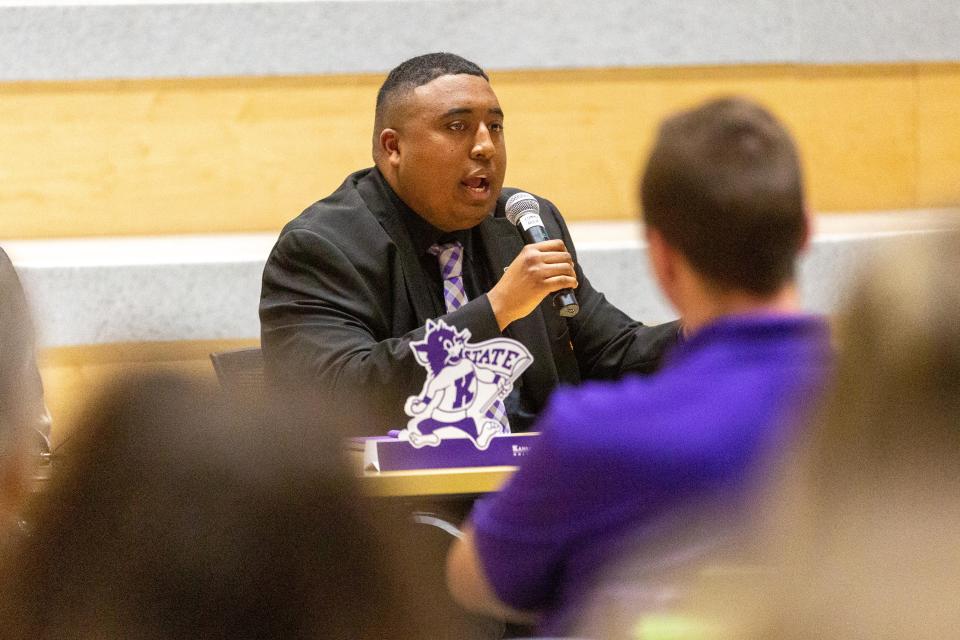Teacher panel explores ways to grow the next generation of Kansas educators

Maggie Murphy knows she’ll be a teacher one day, because those are just the vibes at the Topeka Center for Advanced Learning and Careers.
The Topeka West High School junior is also a student in the Teaching as a Profession career pathway at the center, which is offered through Topeka USD 501 for Shawnee County high schoolers looking to explore various career opportunities.
“The energy here at TCALC is amazing,” Murphy said. “The teachers and staff are at the door when you walk in, and they’re happy to have you here. They want you learn and succeed in your profession, and that just makes a huge difference.”
More:This Topeka USD 501 school has an in-house program to grow the next generation of teachers
More:New K-State initiative to bring 'supercharged' business support in all 105 Kansas counties
Murphy was one of three panelists who shared her experience either as a future teacher, educator or school leader as officials around the state explore ways to engage more young people and adults into the teaching profession.
The panel, hosted by Kansas State University at the student career center, was one of several sessions organized by university leaders as part of President Richard Linton’s initiative to visit communities around the state and partner with local leaders to help grow Kansas’ economy.
Linton told attendees of the panel that having “the right quality of teachers and enough teachers to teaching” is vital to that economic development mission.
Panel: Kansas school leaders should promote teaching as a career
Angela Pomeroy would not have one of her best teachers under her wing if it wasn’t for a tap on the shoulder.
The Jardine Elementary School principal, herself the daughter of an educator, made her way to school building leader with the support and encouragement of leaders she respected.
So when Andrea Graham, one of the best substitute teachers in her building, showed great promise as someone who could work with children, Pomeroy urged Graham to go back to school and get her degree.
More:Compact could help out-of-state teachers get Kansas licenses. State board not convinced yet
“She thought that (being a substitute teacher) was all that she was capable of doing, but she was phenomenal with children,” Pomeroy said.
Pomeroy said she doesn’t even remember urging Graham to get her full teaching license, but years later, the educator, now a first-grade teacher at Jardine Elementary, credits Pomeroy with inspiring to reach her dreams.
She said school building leaders and staff should do more to encourage that kind of ambition in teachers, students and staff members they may not initially see as educators.
“That is what I want my legacy to be,” Pomeroy said. “If I can impact or help people see something they maybe don’t see in themselves, (I hope) it implants enough of a seed for them to decide to grow.”
More Kansas teachers should look like the students they serve

One of the most fulfilling things about teaching for panelist Byron Lewis is having the opportunity to work with students who look like him.
Lewis, who is a Black Topeka native and USD 501 graduate, returned to the capital city after he graduated from K-State with a degree in education. At the university, he had been a member of the College of Education’s Call Me Mister program, an initiative to get more Black and Hispanic men to become teachers.
“I want the future of teaching to look more like the students we serve,” said Lewis, now a second-grade teacher in Turner USD 202.
A hurdle for other prospective educators of color like him, though, is the financial aspect of teaching. He suggested figuring out a way to have schools pay their student teachers for the work they provide, even if still learning on the job like the internships in most other industries.
“I want it more equitable for people who want to be teachers, and to make that a reality for them,” Lewis said. “Those people who want to be there, they would naturally be more empathetic and there for the right reasons.”
More:In one of Kansas' most diverse districts, teachers of color still underrepresented
Teacher academies around Kansas could help engage more high schoolers in the education field
Murphy, the Topeka West junior, may only be in her first year in the TCALC Teaching as a Profession pathway, but it’s a year that’s only deepened a love for education that began years ago.
“I would say that when I was in third or fourth grade with my teachers, I just liked seeing the love they had in their hearts and the passion that they really wanted to impact students,” Murphy said. “It really opened my eyes to even being a teacher.”
More:In face of job dissatisfaction, Kansas teacher vacancies continue to rise
At TCALC, Murphy said she is surrounded by students and teachers who are just as passionate about education, and those same people will help her overcome any barriers she might face on her career path.
“If there was a way for every district to have something like TCALC, it would make a difference in so many people’s lives,” Murphy said.
The Monday afternoon panel came as state-level task forces and committees brainstorm ideas to help alleviate the shortage of teacher candidates that some Kansas school districts are seeing. Data from the Kansas State Department of Education earlier this fall suggested there were more than 1,600 education positions vacant in districts around the state.
More:How can Kansas put students into teacher pipeline? Start with more money, task force says.
Debbie Mercer, dean of K-State’s College of Education, serves on two of the task forces, which have put forth recommendations on items like scholarships, student teacher pay and licensing to make it easier for prospective teachers to get into the classroom.
“There’s nothing better in the world than being a teacher, and I hope you all have that in your heart as you walk out today, and I hope you tell other people that,” Mercer told the crowd of panel attendees. “We need society to elevate the work that happens each and every day in every Kansas classroom in every Kansas school building.”
Rafael Garcia is an education reporter for the Topeka Capital-Journal. He can be reached at rgarcia@cjonline.com or by phone at 785-289-5325. Follow him on Twitter at @byRafaelGarcia.
This article originally appeared on Topeka Capital-Journal: Kansas teacher shortage panel discusses how to grow more educators

